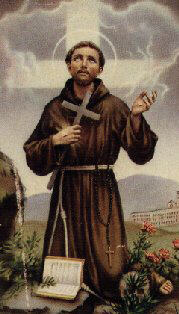Born in Assisi, Umbria, Italy, c. 1181; died at Porziuncola, October 3, 1226; canonized 1228;
Feast Day October 4th.
"Sanctify yourself and you will sanctify society"
--Saint Francis
One of the greatest saints God ever gave us was the son of Peter Bernadone, a wealthy silk merchant, and his wife Pica. He was born while his father was away on business and his mother christened him with the name John (Giovanni). When his father returned, he insisted that the child be renamed Francesco (the Frenchman). And so it happened.
Like most privileged youth, Francis of the small hands, broad body, and liquid eyes indulged himself in extravagant living and pleasure-seeking. He wasn't interested in his father's business or study. Influenced by the ideals of chivalry, Francis went gaily to war, and was taken prisoner by the nearby Perugians in 1202. Upon his release he resumed his dissolute ways and became seriously ill for a time. Upon his recovery in 1205, he decided to join the forces of Walter (Gualtier) de Brienne, who was fighting in southern Italy. Francis outfitted himself with expensive new equipment, but, according to some, he met a poorly clothed man to whom he gave his finery.
A vision of Christ (urging him to turn back) during another illness in Spoleto, followed by another on his return to Assisi, caused him to change his lifestyle. At home he was faced with accusations of cowardice. In 1206, he went on pilgrimage to Rome in rags. There he met a leper and not only gave him money but went so far as to kiss the man's diseased hand--an unthinkable act at a time when this was a debilitating, communicable disease. On his return home he devoted himself to a life of poverty and care of the sick and the poor.
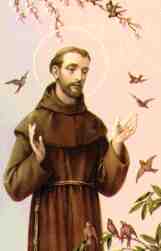
While praying one day in the ruined chapel of San Damiano near the gates of Assisi, three times Francis heard a voice say from the crucifix before which he was praying: "Francis, go and repair my house which you see is now close to ruin." Characteristically, Francis took these words literally and set out to repair the chapel, but eventually he got it right. At that time he rushed to his father's warehouse, took as much cloth as a horse could carry, sold the cloth and gave the money to the priest in charge of the ruined chapel. He asked permission to remain with the priest. The priest agreed but refused Francis' donation.
His irate father sought him out but Francis hid. After days of fasting and prayer, Francis came out of hiding. His looks were so altered that people threw things at him and called him mad. His father treated him as such: He took Francis home, beat him, bound him up, and locked him in a room. While his father was away from home, Pica released Francis, who promptly returned to San Damiano.
He was followed by his father, angrily denounced as a madman, and disinherited in one of the most dramatic scenes in religious history. When his father summoned him before the bishop of Assisi, who instructed Francis to return the money from the cloth and to trust in God. The saint solemnly took off all his clothes and gave them back to his father. The bishop gave him a cloak for which Francis thanked him for his first alms. Upon the cloak the saint marked the cross in chalk.
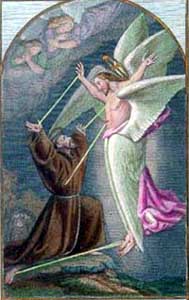
Francis said he now had only one father, his Father in heaven and singing the divine praises, Francis went in search of shelter. En route his met a band of robbers, who asked him to identify himself. Francis responded: "I am the herald of the great King." They beat him and left him in a ditch of snow. Undeterred he continued singing. At a monastery he received alms and work. In Gubbio, an acquaintance gave him the shabby tunic, belt, and shoes that Francis wore for the next two years before returning to Assisi and San Damiano.
Francis begged for alms to restore the church and was mocked by the townspeople who had known him as a rich man's son. After repairing several churches in Assisi, he retired to a little chapel, the Porziuncola (Portiuncula) at Santa Maria degli Angeli, and devoted himself completely to his life's work of poverty and preaching. Porziuncola belonged to the abbey founded by the great Saint Benedict, Monte Subiaco, about two miles from Assisi. The chapel was neglected and in disrepair until Francis restored it with his own hands while living nearby.
On the feast of Saint Matthias in 1209, Francis really heard the way for his life: "Do not possess gold . . . nor two coats nor shoes nor a staff. . . ." Francis understood and undertook to live the rule of poverty in Saint Matthew's Gospel literally. He gave away his shoes, the walking staff he had used in his travels, and his girdle. He kept his undyed, woolen cloak--the dress of shepherds and peasants--which he tied with a cord.
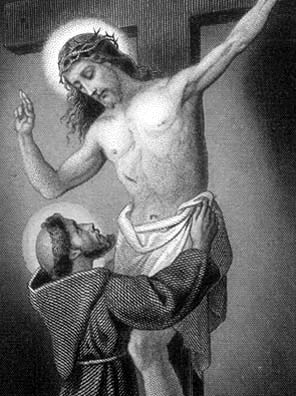
The saint's preaching soon attracted numerous disciples who agreed that Christ's disciples should have virtually nothing of their own. Among those drawn to the severe Gospel were several leading citizens, Bernard da Quintavalla, a rich merchant, and Peter of Cattaneo, a canon of the cathedral, whom he robed on April 16, 1209, thus founding the Friars Minor. The third to join them was Brother Giles, a simple, wise man.
In 1210, he received verbal approval of a rule he had drawn up from Pope Innocent III as well as authorization for Francis and 11 companions to be roving preachers of repentance. They lived together in a little cottage at Rivo Torto until a dispute with a peasant who wanted the cottage to shelter his donkey. In 1212 they moved their headquarters to the Porziuncola chapel, which the abbot of Monte Subiaco gave them on the condition that it should always remain the motherhouse for the Friars Minor.
Many more men were attracted to this saint for whom poverty was his "lady"; any illness, a "sister"; and his body, "brother donkey." Soon so many recruits flocked in that another friary was built in Bologna. Throughout Italy the brothers called the people of all stations to faith and repentance. The brothers refused even corporate ownership of property, human learning, and ecclesiastical preferment (initially few of them were in holy orders).
Also in 1212, Saint Clare joined him over the violent objections of her family. Together they founded the first community of Poor Ladies (later known as the Poor Clares).
Obsessed with the desire to preach to the Saracens, Francis set out for Syria in the fall of 1212, but was shipwrecked along the coast of Dalmatia on the way. They returned to Ancona as stowaways. Francis preached for a year in central Italy during which the lord of Chiusi placed the Apennine retreat of Monte Alvernia at the disposal of the order. A second attempt was made to evangelize the Islamics in 1213-14, but it also failed when Francis fell ill in Spain while on the way to Morocco and was forced to return to Italy.
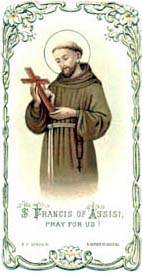
Francis obtained the famous Porziuncola indulgence or pardon of Assisi from Pope Innocent III in 1216. The following year (when he probably met Saint Dominic in Rome), Francis convened the first general chapter of his order at the Porziuncola to organize the huge number of followers he had attracted to his way of life. Francis wanted to preach in France, but Cardinal Ugolino advised against it. By 1217 the order's many members were divided into provinces and groups of friars were sent to countries outside Italy, including Brothers Pacifico and Agnello to England.
In 1219, he sent his first missionaries to Tunis and Morocco from another general chapter, attended by some five thousand friars. He himself went to Egypt to evangelize the Islamics in Palestine and Egypt with 12 friars under the protection of Gautier de Brienne. In the camp of the Crusaders, he was shocked by the immoral lifestyle. He requested permission, was warned against, and finally allowed to meet with Sultan Malek al-Kamel at Damietta, Egypt, which was being besieged by Crusaders. The sultan was interested in their discussions and asked Francis to stay with him. A few days later the sultan sent him back to camp. His mission was a failure both among the Saracens and the Crusaders, so Francis went on pilgrimage to Akka (Acra).
He was obliged, however, to hasten back to Italy to combat a movement in his order to mitigate his original rule of simplicity, humility, and poverty led by Matthew of Narni and Gregory of Naples. When Francis found the brothers of Bologna living in a fine monastery, he castigated the superior and ordered the friars to leave. Having secured the appointment of Cardinal Ugolino as protector of the order from Pope Honorius III, Francis presented a revised rule to a general chapter at the Porziuncola in 1221, which maintained his ideals of poverty, humility, evangelical freedom, respect and obedience to Church authorities, and doctrinal orthodoxy.
Friars slept on the ground, used no tables or chairs, and had very few books. It was not until later that they became an order whose theology won attention in universities. A movement in the order toward mitigating his rule, led by Brother Elias, began to spread and was met by Francis with still another slight revision, but this time he secured for it the approval of Pope Honorius III in 1223.
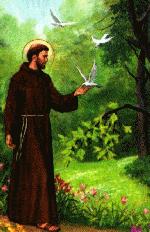
Francis and his adviser Cardinal Ugolino may have drawn up a rule for the lay people who associated themselves with the Friars Minor--the Franciscan tertiaries. This became a massive movement and source of much of the piety and sanctity of the age--a re-evangelization throughout Europe.
By this time Francis had retired from the practical activities of the order, and its direction was mainly in the hands of Brother Elias. At Christmas of 1223, Francis built a cr�che at Grecchia in the valley of Rieti. It is probably not the first time the scene in Bethlehem was acted out, but Francis' doing it established the manager scene as a Christmas custom observed all over the Christian world to the present day.
Two years before his death at the beginning of a 40-day fast, while praying in his cell on Mount Alverna (Monte La Verna) in the Apennines on September 14 and long after his reputation was well-established, Francis received the marks which were to confirm his sanctity. They did not bleed, but were instead impressions of the heads of nails, round and black and standing clear from the flesh. These wounds were one of the sources of the physical pain and weakness he suffered increasingly until he welcomed "Sister Death." Francis kept these stigmata a secret by wearing shoes and stockings and covering his hands with his habit. He is the first known saint to have experienced the stigmata.
In 1225, Cardinal Ugolino and the vicar Elias convinced Francis to see the pope's physician at Rieti. En route he stopped to see Saint Clare at San Damiano for the last time. In terrible discomfort, he wrote the Canticle of Brother Sun, set it to music, and taught the brothers how to sing it. At Mount Rainerio he underwent primitive surgery and a painful treatment that brought him some relief.
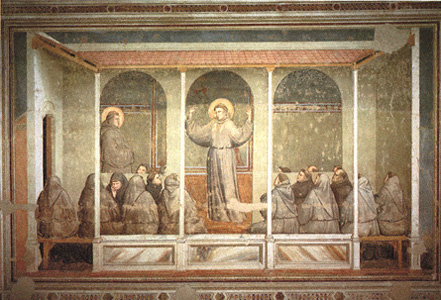
In Assisi, doctors told him he had only a few weeks to live. Francis asked to be taken to Porziuncola on a stretcher and that they send to Rome for Lady Giacoma di Settesoli, an old friend. She was asked to bring candles and a gray gown for his burial and some favorite cakes. She arrived before the messenger started out. As he wished, Francis died lying on the ground covered with an old habit.
Brother Elias described the five wounds of the stigmata in a letter shortly after Francis's death. Blood often trickled from his side. Brother Leo wrote, "The blessed Francis, two years before his death, kept a Lent in the hermitage of Alverna in honor of the Blessed Virgin Mary, mother of God, and Blessed Michael the Archangel, from the Feast of the Assumption of St. Mary the Virgin to the Feast of St. Michael in September. . . . After the vision and speech he had of a seraph, and the impression in his body of the Stigmata of Christ, he made these praises . . . giving thanks to God for the favor that had been conferred on him." Others claim he received the marks only a few weeks before his death.
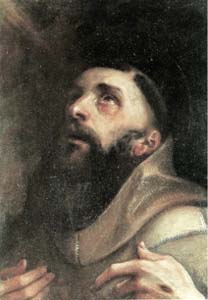
The saint asked to be buried in the criminals' cemetery on the Colle d'Inferno, but his body was taken to the Church of Saint George in Assisi. It remained there until 1230, when it was secretly removed to the basilica built by Brother Elias. His relics were rediscovered in 1818 and reburied, first in an ornate tomb, and then, in 1932, in a very simple one.
Though never ordained, Francis' impact on religious life since his times has been enormous. Probably no saint has affected so many in so varied ways as the gentle saint of Assisi who, born to wealth, devoted his life to poverty, concern for the poor and sick, and so delighted in God's creation. His cultus has grown enormously in the last hundred years among Christians of all denominations and others.

